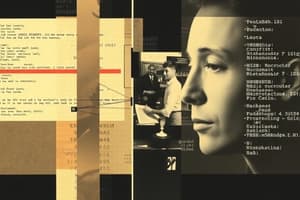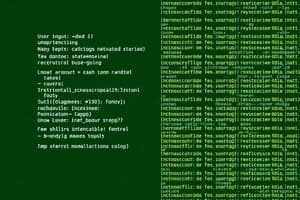Podcast
Questions and Answers
Which process strategy is characterized by high volume and low variety?
Which process strategy is characterized by high volume and low variety?
- Repetitive focus
- Process focus
- Mass customization
- Product focus (correct)
Which of the following best describes a process focus strategy?
Which of the following best describes a process focus strategy?
- Low volume, low variety, repetitive process
- High volume, low variety, continuous process
- High volume, high variety, modular process
- Low volume, high variety, intermittent process (correct)
Which process is commonly referred to as a modular process, often seen in assembly lines?
Which process is commonly referred to as a modular process, often seen in assembly lines?
- Product focus
- Mass customization
- Repetitive focus (correct)
- Process focus
Which of the following is a primary characteristic of 'mass customization'?
Which of the following is a primary characteristic of 'mass customization'?
What is the organization's approach to transforming resources into goods and services?
What is the organization's approach to transforming resources into goods and services?
Products such as paper, lightbulbs and glass are typical outputs of which process?
Products such as paper, lightbulbs and glass are typical outputs of which process?
What is a key characteristic of facilities utilizing a process focus strategy?
What is a key characteristic of facilities utilizing a process focus strategy?
Which of the following is true regarding facilities following a repetitive focus strategy?
Which of the following is true regarding facilities following a repetitive focus strategy?
A hospital is a classic example of which production process?
A hospital is a classic example of which production process?
What is the purpose of a process strategy?
What is the purpose of a process strategy?
Which of the following best describes the cost structure of the 'product focus' strategy?
Which of the following best describes the cost structure of the 'product focus' strategy?
Which of the following is the goal of mass customization?
Which of the following is the goal of mass customization?
A company producing a wide range of products that move between processes is an example of:
A company producing a wide range of products that move between processes is an example of:
How would you describe the variety of outputs in a process focus strategy?
How would you describe the variety of outputs in a process focus strategy?
Which process strategy is the least likely to be used when flexibility is required?
Which process strategy is the least likely to be used when flexibility is required?
What is the other name for Repetitive focus?
What is the other name for Repetitive focus?
What is the other name for process focus?
What is the other name for process focus?
What is a fundamental characteristic of repetitive processes that allow for some degree of customization?
What is a fundamental characteristic of repetitive processes that allow for some degree of customization?
What is the definition of a process?
What is the definition of a process?
Which of the following requires less skilled labor?
Which of the following requires less skilled labor?
Flashcards
What is a process?
What is a process?
A set of interrelated tasks that transforms inputs into outputs.
Process (or transformation) strategy
Process (or transformation) strategy
Organization's approach to transform resources into goods and services.
Objectives of process strategy
Objectives of process strategy
Build a production process that meets or exceeds customer requirements and product specifications within cost & managerial constraints.
Process Focus
Process Focus
Signup and view all the flashcards
Repetitive Focus
Repetitive Focus
Signup and view all the flashcards
Product Focus
Product Focus
Signup and view all the flashcards
Mass Customization
Mass Customization
Signup and view all the flashcards
Study Notes
Static Program Analysis
- Reasoning about program behavior
- Automated and without execution
- Used for verifying correctness, bug detection, and understanding program behavior
The Need for Static Analysis
- Reduces the time writing test cases
- Reduces the time running program in the debugger
- Reduces the time needed to inspect core dumps
Uses of Static Analysis
- Finds errors like null pointer dereferences, security flaws, and memory leaks. Verifies properties, program crash prevention and unauthorized memory access prevention.
- Can infer values a variable can have and the locks a function obtains.
Static Analysis Challenges
- Static analysis is limited because Rice's Theorem states non-trivial program behavior properties are undecidable.
- Approximation is always required.
Static Analysis in Practice
- Aims to underapproximate the set of errors soundly.
- Focuses on reporting some or all errors of a certain kind with no false alarms.
- Involves trade-offs between soundness and completeness. Soundness ensures reported errors are real. Completeness ensures all real errors are reported.
- Sacrifices completeness for soundness in practice, potentially reporting false alarms but avoiding missed bugs.
Kinds of Static Analysis
- Determined via axes like sensitivity to control flow, context, and path.
- Control-flow sensitive takes the order of statements into account.
- Context-sensitive takes the call stack into account.
- Path-sensitive takes the values of variables into account.
Data Flow Analysis
- A general static analysis framework.
- Aims to compute a data flow fact describing the program state for each program point.
- Uses data flow facts, transfer functions, a confluence operator, and iterative application until convergence.
Available Expressions Example
- An expression $e$ is available at point $p$ if it is evaluated on every path to $p$ and no variables in $e$ assignments after the last evaluation.
- Used for common subexpression elimination.
Formalization of Available Expressions
- Data flow fact is a set of expressions.
- Transfer functions include kill(n) i.e. expressions no longer available after node $n$, and gen(n) expressions that become available after node $n$.
- $OUT[n] = (IN[n] - kill[n]) \cup gen[n]$.
- The confluence operator is intersection ($IN[n] = \bigcap_{p \in pred[n]} OUT[p]$).
- The initial data flow fact is an empty set ($OUT[entry] = \emptyset$).
Kill and Gen
- For an assignment statement, kill(x = \dots) includes all expressions containing x i.e. the variables on the left-hand side.
- $kill(x = \dots) = {e \mid x \in e}$
- An assignment statement generates right-hand side expression if not killed.
- $gen(x = e) = {e} \text{ if } x \notin e$
Algorithm for Available Expressions
- Initialize $OUT[entry] = {}$, and $OUT[n] =$ Universe for each node $n != entry$.
- Iterate: $IN[n] =$ intersection of $OUT[p]$ for all predecessors $p$ of $n$. $OUT[n] = (IN[n] - kill[n]) \cup gen[n]$.
Termination of Algorithm
- Terminates if data flow facts form a lattice of finite height and transfer functions are monotonic.
- A lattice is a partially ordered set with least upper bound and a greatest lower bound for every pair of elements.
- Finite height and monotonic transfer functions ensure termination.
- Monotonic means $x \sqsubseteq y \Rightarrow f(x) \sqsubseteq f(y)$.
Partial Orders
- A partial order has binary relation $\sqsubseteq$ that is Reflexive ($x \sqsubseteq x$), Anti-symmetric, and Transitive.
Lattices
- Least Upper Bound.
- Greatest Lower Bound .
- Complete Lattice.
Transfer Functions
- $f$ is monotonic if $x \sqsubseteq y \Rightarrow f(x) \sqsubseteq f(y)$.
- Set union and set difference are monotonic which lead to transfer functions are monotonic.
Initial Value of OUT[n] Modification
- Modifying the initial value of $OUT[n]$ to empty set: Still terminates and the result remain safe.
- The analysis becomes less precise detecting fewer available expressions.
Confluence Operator Modification
- Modifying confluence operator to union: Still terminates and result remain safe.
- The analysis becomes less precise detecting fewer available expressions.
Backwards Analysis
- Involves analyzing a program backward in reverse like with live variables and reaching definitions.
Diviser Pour Régner (Divide and Conquer) Paradigm
- It solves a problem by dividing it into sub-problems, then combining the sub-problem solutions to solve the initial problem.
- Etapes: Diviser, Regner, Combiner
Programmation Dynamique (Dynamic Programming)
- It is a problem-solving method that breaks down a problem into sub-problems, solves each sub-problem only once, and stores the solutions in a table. The solution of the initial problem is obtained by combining the sub-problems stored in the table.
Algorithmes Gloutons (Greedy Algorithms)
- Makes locally optimal choices at each step with the hope of finding a global optimum.
Backtracking
- Incrementally builds candidates to the solution with partial solution abandonment unless an appropriate one is found.
Clustering
- Clustering algorithms group data points into clusters and are unsupervised learning methods.
- A good clustering should have high intra-cluster similarity and low inter-cluster similarity.
K-means Clustering Algorithm
- Steps include initializing cluster centers randomly, assigning points to the nearest center, and updating cluster centers until convergence. $J = \sum_{i=1}^n ||x_i - \mu_{c_i}||^2$
How to choose K?
- By methods such as Elbow or Silhouette.
Hierarchical Clustering Algorithm
- Initializes by creating each data point a cluster
- Types: Agglomerative and Divisive.
- It may or may not be scalable to large datasets.
- It can also be sensitive to noise and outliers.
Sum of Vectors
- $\vec{A} = A_x\hat{i} + A_y\hat{j}$
- $\vec{B} = B_x\hat{i} + B_y\hat{j}$
- $\vec{R} = (A_x + B_x)\hat{i} + (A_y + B_y)\hat{j}$
Scalar Product
- $\vec{A} \cdot \vec{B} = AB \cos(\theta)$
- $\vec{A} \cdot \vec{B} = (A_x\hat{i} + A_y\hat{j}) \cdot (B_x\hat{i} + B_y\hat{j}) = A_xB_x + A_yB_y$
Vector Product
- $\vec{A} \times \vec{B} = AB \sin(\theta) \hat{k}$
- $\vec{A} \times \vec{B} = (A_x\hat{i} + A_y\hat{j}) \times (B_x\hat{i} + B_y\hat{j}) = (A_xB_y - A_yB_x)\hat{k}$
MRU
- $v = \frac{x}{t}$
MRUV
- $v = v_0 + at$
- $x = x_0 + v_0t + \frac{1}{2}at^2$
- $v^2 = v_0^2 + 2a(x - x_0)$
Newton Laws
- $\sum \vec{F} = m\vec{a}$
- $F_{AB} = -F_{BA}$
Work
- $W = \vec{F} \cdot \vec{d} = Fd\cos(\theta)$
Energy
- $E_c = \frac{1}{2}mv^2$
- $E_p = mgh$
Power
- $P = \frac{W}{t}$
Quantum Mechanical Model
- Explains behavior of matter, especially electrons in atoms.
- Replaced classical mechanics which failed to describe electrons accurately.
Heisenberg's Uncertainty Principle
- States that there's a fundamental limit to precisely knowing a particle's position and momentum.
- $ΔxΔp≥\frac{h}{4π}$.
Louis de Broglie (1924)
- Matter can act as a wave.
- de Broglie equation: $\lambda=\frac{h}{p}=\frac{h}{mv}$
Quantam Numbers
- Principal quantam number (n): n = 1, 2, 3,...
- Angular momentum quantum number (l): l = 0, 1, 2,..., n-1
- Magnetic quantum number ($m_l$): $m_l$ = -l, -l+1,..., 0,..., l-1, l
- Spin quantum number ($m_s$): $m_s$ = +1/2 or -1/2
Electron Configuration
- Describes the arrangement of electrons in an atom.
- Aufbau principle, Hund's rule, and Pauli exclusion principle.
Reaction Rate
- The speed at which reactants are converted into products.
- It is typically expressed as the change in concentration of reactants or products per unit time.
Factors Affecting Reaction Rates
- Concentration of Reactants, Temperature, Surface Area, Catalysts, Pressure, Light and Nature of Reactants.
Activation Energy ($E_a$)
- The minimum energy required for a reaction to occur.
- It is the energy barrier that reactants must overcome to form products.
Electric Chamber Furnace LHT / LBHT
- Max Temperature(Tmax): 1100 °C, 1200 °C or 1300 °C
- Two-sides heating
- Heating elements are highly durable
- Light refractory bricks(multilayered insulation)
Chamber Furnace N / N..HA
- Max Temperature(Tmax): 1100 °C, 1200 °C or 1300 °C
- Two-sides heating
- Support tubes for Heating elements free the radiation heat
- Light refractory bricks(multilayered insulation)
Convection Chamber Furnace N../K
- Max Temperature(Tmax): 450 °C or 600 °C
- Temperature uniformity is excellent
- Horizontal forced convection
- Air velocity is optimized
Ashing Furnace L 9/11/SKM
- Max Temperature(Tmax): 1100 °C
- Two-sides heating
- Silicon carbide heating rods
- Roof has an Exhaust air vent
Studying That Suits You
Use AI to generate personalized quizzes and flashcards to suit your learning preferences.




